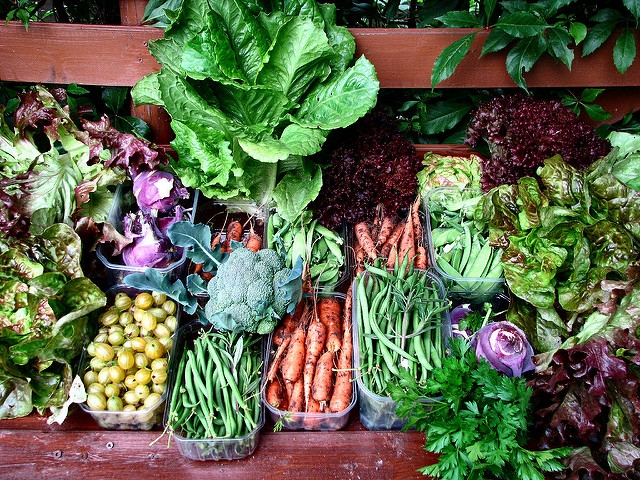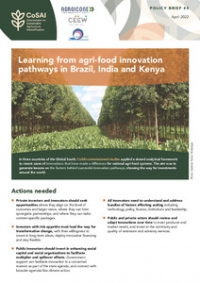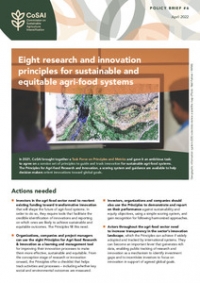This piece was originally posted on The Global Forum for Agricultural Research's blog
Deciding to write for an agricultural research and development forum about how we should not be focusing on feeding the world, might seem a bit counterintuitive. But bear with me, because as a previous “Feed the World” advocate myself, I hope to explain properly about why we should leave this way of thinking.

The current narrative considers one goal and one goal only: maximizing yields and profits no matter the social costs or environmental consequences.
This can all be changed if we take a look at diversified agroecological systems, obviously enough. No, but what exactly is a diversified agroecological system? Simply speaking, it is an agricultural system that is wholly sustainable. The primary focus of these systems may be environmental sustainability, but other important aspects include:
- Social equity
- Local economic prosperity
- Public health
- Rural development
- Being socially well-situated in the local cultural landscape
- Minimized disruption to ecological and social systems
These systems should also work to contribute to a larger global system that is sustainable, socially just, and food secure. And yet, even with their success, methods such as sustainable farming, organic agriculture, and crop diversification are not the current standards or even the major trends for agriculture. Instead, agricultural production is still dominated by unsustainable systems such as monoculture and industrial farming. But why is this the case when there is so much evidence that sustainable methods are far better, especially in the long run?
Emile Frison, as part of the International Panel of Experts on Sustainable Food Systems (iPES-FOOD) presented eight key reasons or obstacles for why the shift towards more sustainable food systems is not happening:
- Sunken investment in current food system infrastructure
- Emphasis on export or ‘cash’ crops
- Expectations of cheap food
- Narrow and segmented views on the agrifood system instead of an interdisciplinary scope, including within governments and organizations
- Short-term thinking and policies
- Incomplete measures of agricultural success skewing the perceived returns on different systems
- Concentrated power in few large companies which have reason to maintain current systems…
- …and finally the “Feed the World” narrative
Though I will focus on the last reason, each of these eight obstacles are important and compelling, and need to be tackled individually in order to change the current paradigm.
There are currently 795 million undernourished in the world today. This is a startling number, and one which calls for action to be taken. But it is crucial in the long run that the action taken is strategic in nature.
Too often this narrative gives credibility to those calling for continued stagnation in the current unsustainable food systems. This is a narrative that allows pushes for greater calorie production to trump nutritional considerations, that allows rural development to stagnate as large amounts of food are imported, and that does not consider the long term negative impacts on the environment and future agricultural production ability of current farming methods.
But we cannot allow those voices and those views to be the one driving the agricultural landscape. We cannot keep pushing the current systems to solely maximize yields. Because when looking at current agricultural yields, we can already feed the global population. We can even feed the highest predicted 2050 global population of 10 billion. The problem does not lie in our global output.
The problem is complex, and this is what often gets lost in the “Feed the World” rhetoric. Two of the most notable reasons for global hunger are poverty and unequal access to food. We know producing more food globally does not automatically mean that more food will reach those who need it. Increasing yields, improving food aid, and greater food exports has not and will not lift those 795 million undernourished.
Instead we need to focus on creating holistic solutions where communities and regions can grow a diverse array of crops, that contribute to their overall food and economic security in an environmentally sustainable manner.
This should not only alleviate world hunger today, but it should also ensure that we are setting up systems in which we can continue to feed the greater populations of tomorrow.
So that is why I say the “let’s feed the world” rhetoric needs to die. Because it is a narrow mentality that can be used to imply that one region or one system can actually feed the entire world.
So instead, let’s feed our families. Let’s feed our communities. Let’s feed our countries. And maybe let’s even contribute to feeding our regions. And let us do this sustainably, and equitably, and with a focus on human health from the outset.
And then maybe we won’t actually have to worry about feeding the world.















Comments
Thanks for this very important conversation.
As long as 'hunger' remains the problem, increased production remains the solution, blocking research on equity, distribution, fair access to culturally appropriate foods. Happy to see CGIAR writing about this.
"by always framing things in the negative, we may find solutions to those problems but we won’t change the system in which the problems arose. Improving seed varieties may solve aspects of world hunger, but it won’t change the system which makes hunger pathological. We can use food as a lens to talk about global food problems: 1) Food frames problems in the positive..."
A blog response to a plenary at EAT forum 2 years ago which includes a reflection on the need for more positive stories to incite action: https://jamilathelorax.wordpress.com/2014/06/19/695